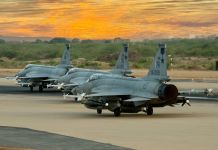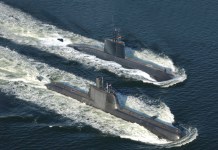US Defense Secretary Lloyd Austin has approved an extended deployment of the USS Eisenhower aircraft carrier in the Middle East and the deployment of long-range B-52 bombers to the region.
Two B-52 bombers have already arrived, as a move to provide US forces in Afghanistan protection during the pullout, Pentagon spokesperson John Kirby said at a press briefing.
US and NATO forces in Afghanistan will withdraw ground forces from the country by May 1 and they aim to complete the pullout by September 11.
“[Austin] He has approved some additional measures today, he has approved the extension of USS Eisenhower to remain in the Central Command area of responsibility for a period of time and he has approved the addition of some long-range bombers to be deployed to the region,” Kirby said on Friday. “Two of those B-52s have arrived in the region.”
The US Air Force in a separate statement said the two US B-52 bombers from the state of North Dakota arrived at Al Udeid Air Base in Qatar.
Kirby said it is possible there can be a temporary increase of US ground forces in Afghanistan who will help facilitate an orderly withdrawal.
US media reported earlier on Friday that the United States is already starting to remove military equipment from Afghanistan. Kirby confirmed the report, adding that equipment will be brought to the United States, deployed to other regions in the world, transferred to Afghan security forces, or destroyed.
Moreover, Kirby said all military equipment will be shipped out of Afghanistan by air but he does not have an estimate at the moment of how much the US withdrawal operation will cost.
In the meantime, Afghanistan is still witnessing clashes between Taliban insurgents and the Afghan military despite the launch of peace talks between the movement and Kabul in Qatar’s Doha last September.
US Central Command (CENTCOM) Commander Kenneth McKenzie said on Thursday that intra-Afghan peace talks currently appear to be in a short-term deadlock and emphasized the need for the United States to continue supporting the Afghan government in order to prevent it from collapsing after foreign forces withdraw.
A-Qaeda Still A Threat
Al-Qaeda continues to pose a threat to remaining US personnel in Afghanistan through their interaction with the Taliban, the Department of Defense said in a report to Congress entitled “Enhancing Security and Stability in Afghanistan.”
“AQ [al-Qaeda]’s regional affiliate, AQIS [al-Qaeda in the Indian Subcontinent] poses a threat to US personnel and allies in Afghanistan through its continued interaction with local Taliban commanders,” the report said on Friday.
Earlier this month, President Joe Biden approved a full troop withdrawal from Afghanistan after almost 20 years by September 11. Biden maintained that the main purpose of the US invasion of the country in November 2001 to prevent any future terror attacks on the American homeland had now been met.
The Pentagon report to Congress said al-Qaeda had been degraded in Afghanistan but cautioned that the terror group was still capable of attacking Americans in the country.
“AQ [Al-Qaeda]s remaining core leaders pose a limited threat to US and coalition forces in Afghanistan because the leaders focus primarily on survival,” it said.
The Taliban, al-Qaeda and its regional affiliate al-Qaeda in the Indian Subcontinent (AQIS) along with other violent extremist organizations and organized criminal networks continued to threaten stability and security in Afghanistan, the report added.




